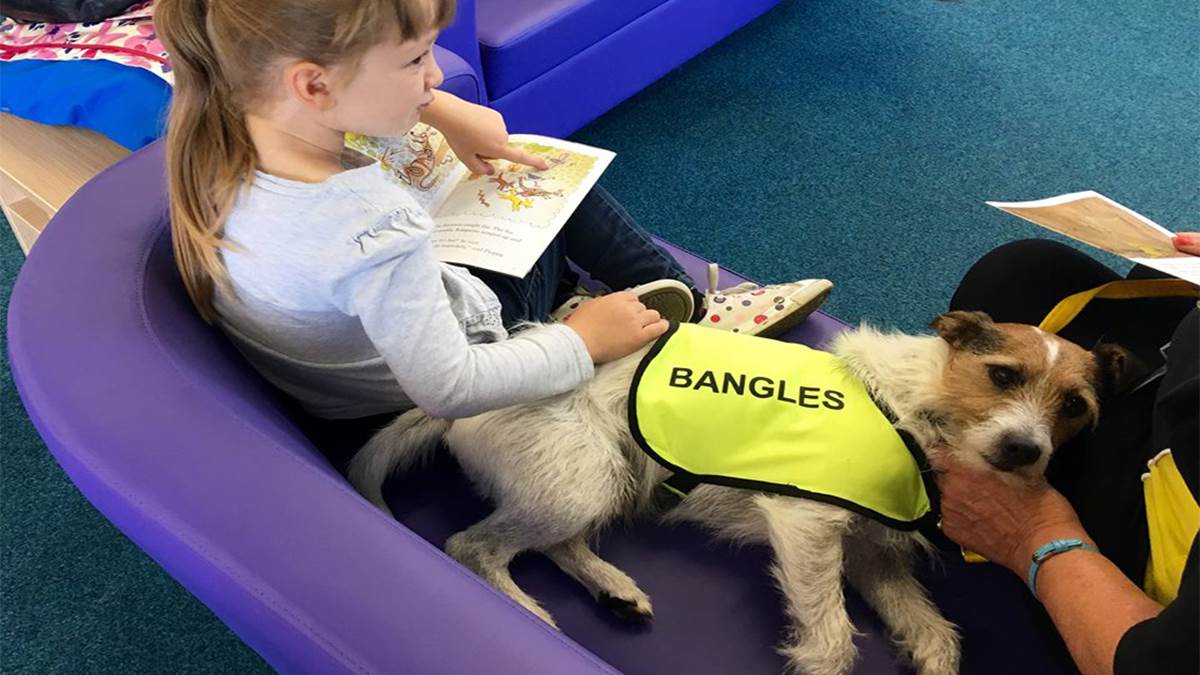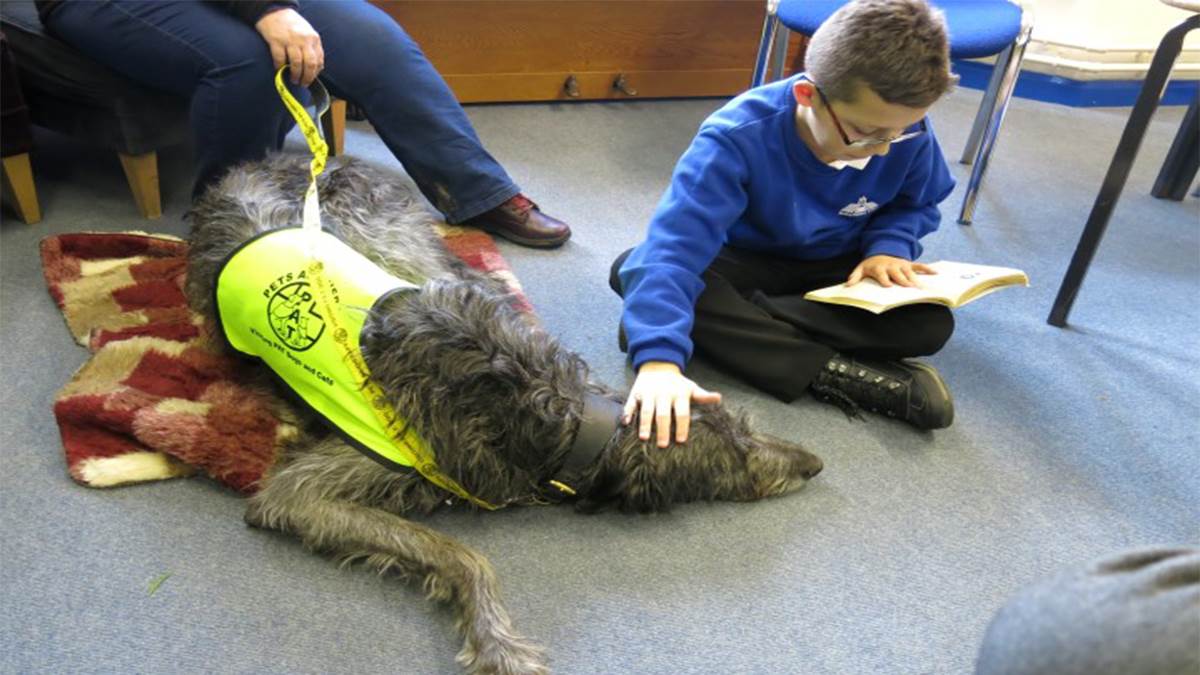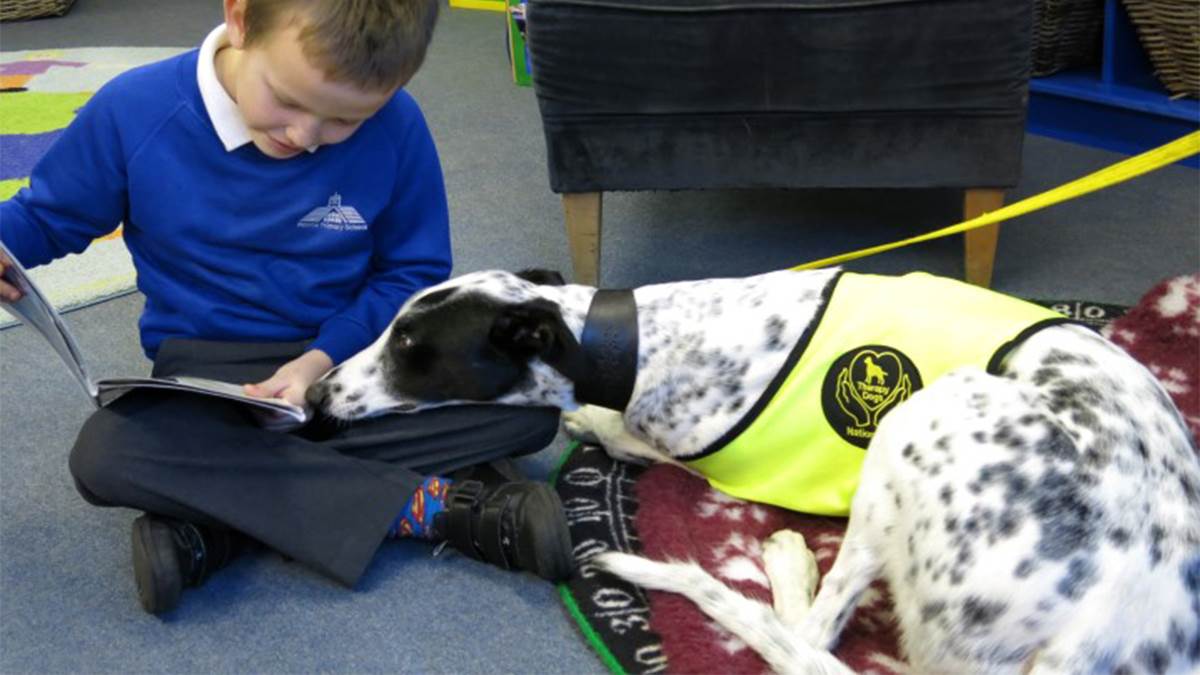How these adorable dogs are helping children love reading
Published on: 26 August 2017 Author: Jaki Brien
Jaki Brien volunteers for Therapy Dogs, so she’s seen first-hand how reading to a dog can be just the thing to help a child love books.

Bangles the dog having an excellent story time
As a long-term "reading dog" volunteer, Jaki Brien talked to us a bit more about this incredible scheme, which sees hundreds of volunteers taking their dogs into schools.
And it sounds like her own doggy, Jem, has a great time, too…
‘Can your dog read?’
So many children ask me this question when they are offered the opportunity to read to Jem!
No, dogs can’t read – but all the volunteers and schools are convinced that something very special happens when dogs and children who struggle with reading come together.
Breaking down reading barriers
It’s worth emphasising that all the children who read to Jem already receive excellent teaching in school. For all sorts of reasons, they struggle – despite everything their teachers are already doing to help them.
Although we’ve worked with very young children, who always enjoy the sessions, I find that older children benefit more. I think this is because they are becoming aware of their struggles with something which their friends find quite easy. Their problems with reading are overlaid with issues of inadequacy or anxiousness, which often shows as rejection of reading as something which they ‘didn’t want to do anyway’.
Because reading to a dog is completely new and non-threatening, we can break down some of these barriers.
What happens in a reading session
It sometimes surprises teachers that I always sit where I can’t see the text. We start with a chat about the book and a quick play with the dog before we settle to reading.
Children read whatever they like and for as long as they wish. When the child decides to stop reading, I thank her on Jem’s behalf and say what I particularly enjoyed about the book. We have another couple of minutes’ play, then (with a reminder about washing hands) the child returns to class.
I never interrupt or make any comment about the quality of the reading. Children read to the dog, not me – and he couldn’t give two hoots when they get something wrong.
The reader is the expert
The dog isn’t just a gimmick to make reading more attractive. Even if the children really struggle with reading, they are much better than the dog. They are reading, not to be instructed or to have their errors pointed out, but to give pleasure.
Reading to the dog helps them to take on the responsibilities, as well as the pleasures of independence. Perhaps for the first time, these children are the experts as they read. This gives them great confidence; there will be no intervention and no assessment.
 Sometimes being read to is just a little too relaxing
Sometimes being read to is just a little too relaxing
Reading out loud
A couple of months into my volunteer work, I began to see (and was told by teachers) how much children’s reading was improving. I realised that the dog gave a unique way to read aloud.
Children told me that when they read silently, they simply skipped the difficult bits. Often, they missed out so much that the text didn’t make a lot of sense. No one gets pleasure or learns from something nonsensical. It isn’t surprising that these children were making little progress.
When reading out loud to a dog, the children begin to listen to themselves and to remember what they’ve been taught.
How children’s reading changes
There is a wonderful moment which usually happens on the second reading session. The reader makes an error, stops, and then corrects themselves. It is so hard not to jump up and yell, ‘You’ve made it – now you are reading like a reader!’
Self-correction is so important. The dog, of course, doesn’t realise this is momentous, so I keep quiet.
Once children are reading for meaning, phrases become more important to them. Gradually, I hear expression improving (I do say that the dog loves to hear different voices for different characters) and punctuation becomes apparent. It is a real pleasure to listen to the book for all of us.
Talking about the text
We talk quite a lot in the session, always focusing on meaning and pleasure. I suspect it sounds a bit like Gogglebox, as we give a commentary on the text, together with the occasional addition of Jem putting his nose on the book to get an extra stroke.
 If Jem's lucky, she'll get a stroke as well as a good story
If Jem's lucky, she'll get a stroke as well as a good story
Children often tell Jem about their book choices – ‘Look, it’s about a Great Dane, only he’s invisible. You like books about dogs, don’t you?’
Our conversations are probably a bit silly, but I’m beginning to think that structured silliness is a very valuable teaching tool.
Can you help us find more dog books?
I am gradually accumulating books about dogs, for the children to read to Jem. This started as a joke, but I am pleased to report that the children want to choose books they think are particularly suitable for the audience.
Let @BookTrust know if you have any suggestions!
Contact a therapy dog charity (Jaki Brien is with Therapy Dogs Nationwide) to find out if there is a registered volunteer near to your school.
Topics: Primary, Animals, Features, Teacher tips
Our favourite dog books
Children's books with the best dogs
This booklist features classic reads, as well as newer books all about dogs of every size and personality. Three woofs for that!
Bookfinder
Find your next book
Use the Bookfinder to find the perfect book for you, your family and friends.






